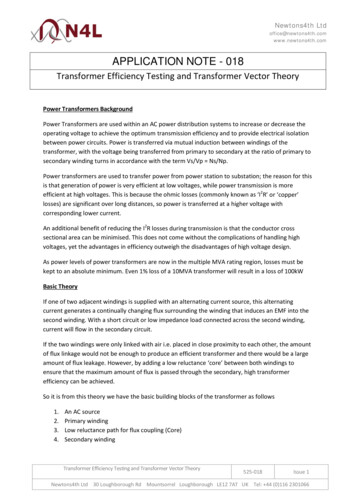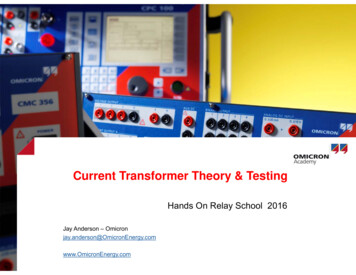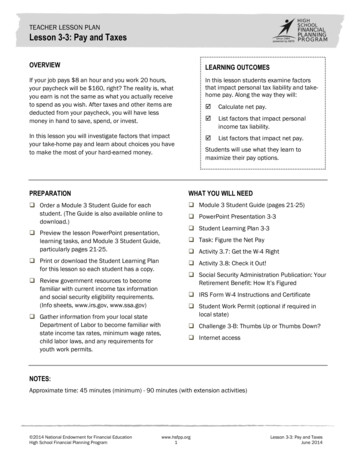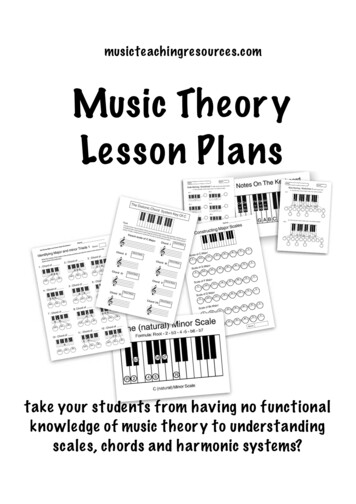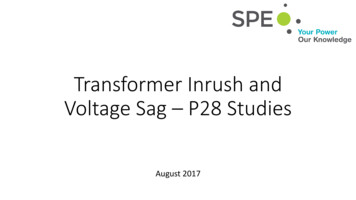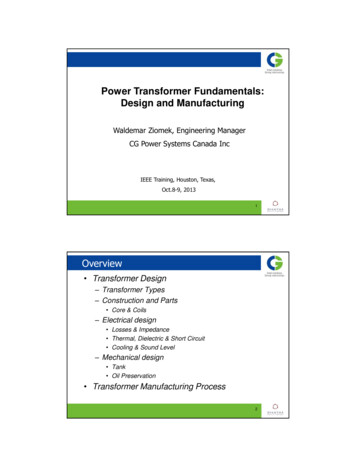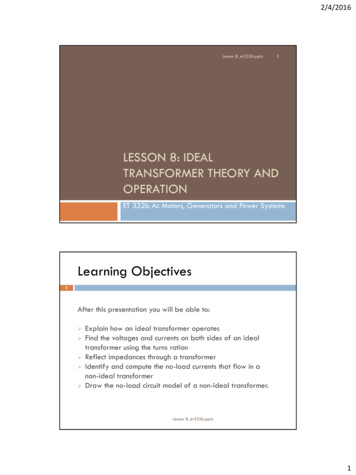
Transcription
2/4/2016Lesson 8 et332b.pptx1LESSON 8: IDEALTRANSFORMER THEORY ANDOPERATIONET 332b Ac Motors, Generators and Power SystemsLearning Objectives2After this presentation you will be able to: Explain how an ideal transformer operatesFind the voltages and currents on both sides of an idealtransformer using the turns rationReflect impedances through a transformerIdentify and compute the no-load currents that flow in anon-ideal transformerDraw the no-load circuit model of a non-ideal transformer.Lesson 8 et332b.pptx1
2/4/2016Ideal Transformer Action3Lentz's Law d e2 N 2 m dt d e1 N1 m dt Induced voltagehas oppositepolarity fromsourcePrinciple: Stationary coils, time varying flux due to ac current flow. Fluxproduced by one coil must link to other coil to induce voltageLesson 8 et332b.pptxIdeal Transformer Action4For sinusoidal sourcesSecondaryPrimaryE p 4.44 N p f maxE s 4.44 Ns f maxDividing the above equations gives:E p 4.44 N p f max E s 4.44 N s f maxE p N p E s N sWhere: E’p voltage induced in the primary (V)E’s voltage induced in the secondary (V)Np turns in the primary coilNs turns in the secondary coilVoltage relationshipfor Ideal transformerVoltage ratio equalsthe turns ratioLesson 8 et332b.pptx2
2/4/2016Assumptions for Ideal TransformerOperation51)2)3)4)5)6)All flux produced in the primary coil links to the secondary coilno core losses due to hysteresis or eddy currentsno power lossespermeability is infinite (no saturation no magnetizing )windings have zero resistanceno current required to magnetize the iron coreFor ideal transformera E p N p Vp E s N s VsWhere: a turns ratioVp nameplate rated primary voltage (higher V)Vs nameplate rated secondary voltage (lower V)E’p induced primary voltageE’s induced secondary voltageLesson 8 et332b.pptxIdeal Transformer Equations6Voltage RatioN p The turns ratio is aE s N s scalar. Introduces nophase shiftE p a Esa Ep Apparent Power balanceE p I p E s IsSp SsNo power losses inidea transformerCurrent Ratio1 1 I IIs a p a sIpCurrent ratio is theinverse of the voltageratioLesson 8 et332b.pptx3
2/4/2016Ideal Transformer EquationsImpedance Transforms7Impedances Reflected Through Ideal TransformersLoad impedance asseen from primaryside of transformerZinZloadBy Ohm’s LawZin EpZload IpEs Write Es and Is in terms of primary values Ep E s a E p 1 E p 1 Isa I p a a I p I p a 2 Lesson 8 et332b.pptxEpIs a I pa 1 Zload Zin 2 a EsIsLoad impedance isincreased whenviewed from primarysideZload a 2 ZinIdeal Transformer EquationsImpedance Transforms8Derive equation when impedances are connected to the primary side andviewed from the secondary side.Write primary values in terms ofEZin ssecondary and substitute in theIsZload equation.Zload Zload EpIpGenerally : Moving impedance from secondaryto primary multiply by a2. Moving fromprimary to secondary, divide by a2.Z p Zs a 2E p a EsZinZloadZpa2 ZsEpIp Ip Isa a E a Es a E s a 2 s Is Is Is aZload Zin a 2 Zload Zina2Lesson 8 et332b.pptx4
2/4/2016Ideal Transformer Calculations9Example 8-1: A 25 kVA, 7200 - 240/120 center-tap single phasetransformer operates at rated voltage. It supplies a single phase load that hasan equivalent impedance of 7.2 36.9o ohms. Assume Ideal operation andfind:a.) turns ratiob.) secondary currentc.) primary currentd.) load Z as seen from primary sidee.) PT, ST, QT, and Fp120 V7200 V240 V120 VLesson 8 et332b.pptxExample 8-1 Solution (1)10a) For ideal transformersAnsb) Secondary currentUse Ohm’s law to find IsAnsLesson 8 et332b.pptx5
2/4/2016Example 8-1 Solution (2)11c) Find the primary currentAnsd) Find the input impedance as seen from the primary sideAnsLesson 8 et332b.pptxExample 8-1 Solution (3)12e) Find the power and the power factor of the loadUsing secondary side quantitiesUsing primary side quantitiesAnsAnsPower equal on both sides of ideal transformerLesson 8 et332b.pptx6
2/4/2016Example 8-1 Solution (4)13Now find the power factor and the active and reactive powersAnsAnsAnsLesson 8 et332b.pptxIdeal Transformer Calculations14Example 8-2: 300 kVA 2400-120, 60 Hz single phasetransformer operates at 2300 volts on the primary side. It supplies115 kVA to a load that has a power factor of 0.723 lagging.Assume idea operation and find:a.)b.)c.)d.)secondary voltage at operating voltagesecondary currentimpedance of the load as seen on the secondary sideimpedance of the load as seen on the primary sideLesson 8 et332b.pptx7
2/4/2016Example 8-2 Solution (1)15a) Find secondary voltage at operating voltageUse rated values to find turns ratioAnsb) Find secondary current at operating voltagePower is equal on bothsides of ideal transformersAnsLesson 8 et332b.pptxExample 8-2 Solution (2)16c) Find load impedance seen on secondary sideNext find impedance angleAngle between V and I.Change sign forimpedance angleAnsLesson 8 et332b.pptx8
2/4/2016Example 8-2 Solution (3)17d) Find load impedance seen on primary side of transformerReflecting impedance from secondary to primary-multiply by a2.AnsLesson 8 et332b.pptxNon-Ideal Operation-No-load18Practical transformers draw current with no load connected to secondary winding.Current caused by two non-ideal conditions: power losses and core magnetizationActive power lossesHysteresis losses - power losses due torepeated change in magnetic polarity. It takesmore mmf (NI) to demagnetize core in onedirection than the other.Eddy currents - ac currents induced in iron coredue to changing magnetic fieldActive power lossControlLesson 8 et332b.pptxControl hysteresis losses - use alloy steels designedfor magnetic circuitsControl eddy current losses - laminate core,insulate laminates9
2/4/2016Non-Ideal Operation-No-load19A finite amount of current is necessary to drive mutual flux between coils.Permeability is finite so reluctance is finite Some NI F needed.R l A m L In terms of inductanceN2RN IR m mutual flux R reluctanceso core has inductance with associatedinductive reactanceDefine above as the magnetizing inductance with associated magnetizingreactance XmLesson 8 et332b.pptxNo-Load Circuit Model20IoVTRfeVT the primary voltageIfe core-loss componentXMI0 exciting currentIM magnetizing componentRfe resistance that represents the core lossesXm inductive reactance that represents the core magnetizing LLesson 8 et332b.pptx10
2/4/2016No-Load Circuit Model21Model equation using phasorsI fe VTR feIM I o Ife j I MVTjX MIo Ife I MAdd current magnitudes at 90 degreesNo-load apparent powerSM VT IoModel parameter formulasPfe 2VTR fe2 R fe Core loss resistanceVTPfeXM VTIMMagnetizing reactanceLesson 8 et332b.pptxNo-Load Transformer Example22Example 8-3: Computing the values of magnetizing reactanceand core loss resistance. A 50 kVA 7200-240 V, 60 Hz singlephase transformer is operating with no load. With the primaryconnected to a 7200 V system, it draws 248 W and has apower factor of 0.187 lagging. Find:a) the exciting current and its componentsb) the magnitudes of magnetizing reactance, XM and core loss Rc) Repeat parts a and b if the transformer is energized fromthe secondary (low voltage) side.Lesson 8 et332b.pptx11
2/4/2016Example 8-3 Solution (1)23a) Find current IoSM magnetizing apparent powerAnsLesson 8 et332b.pptxExample 8-3 Solution (2)24AnsAnsb) Find the value of core loss resistance and magnetizing reactanceAnsLesson 8 et332b.pptx12
2/4/2016Example 8-3 Solution (3)25c) Find same parameters on secondary sidePower constant through transformerAnsLesson 8 et332b.pptxExample 8-3 Solution (4)26qCompute Rfe and XMLesson 8 et332b.pptx13
2/4/2016Example 8-3 Solution (5)27AnsCompare using turns ratio transfer209,032 on primary39,801 on primaryLesson 8 et332b.pptx28ET 332b Ac Motors, Generators and Power SystemsEnd Lesson 8: Ideal Transformer Theory andOperationLesson 8 et332b.pptx14
TRANSFORMER THEORY AND OPERATION ET 332b Ac Motors, Generators and Power Systems Lesson 8_et332b.pptx 1 Learning Objectives Lesson 8_et332b.pptx 2 After this presentation you will be able to: Explain how an ideal transformer operates Find the voltages and currents on both sides of an ideal transformer using the turns ration Reflect impedances through a transformer Identify and
